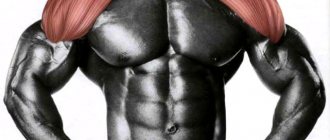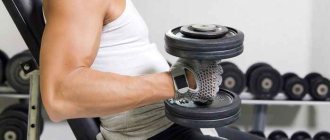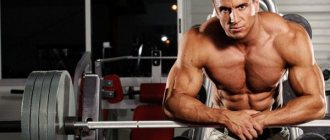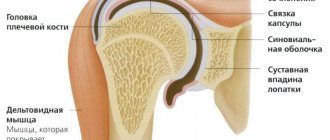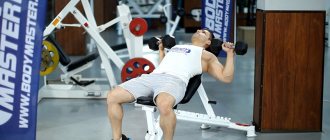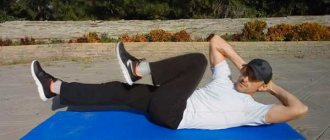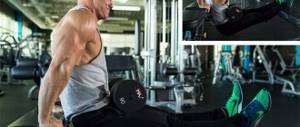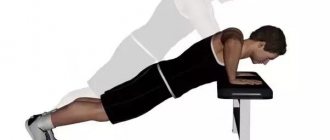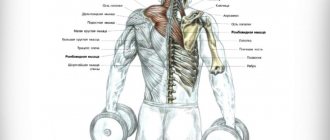Introduction
The shoulders are a relatively small and rather fragile muscle group. Along with a narrow waist and wide back, well-developed shoulders create a sporty silhouette and make the shape athletic. The shoulder consists of three parts: the anterior, middle and posterior deltoid muscle. Accordingly, shoulder training is also divided into beams, loading them in one order or another.
Exercises for the anterior deltas consist of various presses. The middle bunch of deltas is usually worked out in various strokes. The posterior bundle of deltas is developed with all kinds of abductions and tractions. It is also worth remembering that the shoulder joint itself is very fragile and excessive load can easily lead to injury, so when training your shoulders it is worth remembering that huge weights do not always lead to success. This is the peculiarity of training this muscle group. This article will present the most effective exercises for the shoulder muscles, which will allow you to both increase mass and define the relief.
RULES FOR TRAINING SHOULDERS
- The deltoid muscles work when training any muscles of the shoulder girdle, especially the latissimus and pectoral muscles. Exercises with the deltoids immediately after training the back and chest will increase the total presence of the deltoid muscles under load and this will contribute to their better growth and development. If you combine shoulder training with training large muscle groups, place shoulder exercises at the end of the workout.
- If you train your shoulders separately, then after heavy training involving the shoulder muscles, give them enough time to recover. Especially before training your chest or back. Otherwise, the deep muscles of the shoulder will accumulate fatigue and destruction, which will one day lead to overtraining and result in pain.
- In the main basic exercises for the shoulders, the middle bundle of the deltoid muscles receives the load; it is this that plays an important role in the formation of broad shoulders. The anterior and posterior bundles are involved in the work to a lesser extent, so do not forget to include isolating exercises for these bundles in your training for better development.
- When training your shoulders, pay more attention to maintaining the correct exercise technique rather than chasing heavy weights. It is also not recommended to use inertia or facilitate the exercise with jerks. This will help you work your muscles more effectively and reduce the risk of injury.
- Shoulder injury is a common occurrence in bodybuilding. The shoulder joints are the most unstable, which is why injuries to them are so common. Usually the cause of shoulder pain is too much rotation or twisting of the deep-lying muscles of the shoulder joint. To prevent shoulder damage, include circular rotations of your arms in your warm-up before training, and movements to stretch the muscles of the shoulder girdle in your cool-down after training.
Standing barbell press
This exercise for the shoulder muscles involves the anterior and middle deltoids, as well as the rotator cuff muscles. This is a basic exercise used to build shoulder mass and strength. Recommended for advanced and more experienced athletes at the very beginning of shoulder training.
Exercise technique
1. Place the barbell on the racks at chest level and collect the desired weight on it. Grab the bar with a grip slightly wider than shoulder-width apart. 2. Approach the bar end-to-end until your collarbones touch it. Turn your elbows down so that your palms holding the bar are facing up, remove the bar from the racks and take a step back. 3. In the starting position, the chest is straightened, the back maintains a natural curve, legs are hip-width apart, feet are parallel. The bar rests on the palms and touches the collarbones. 4. Inhale and, holding your breath, press the barbell up. At the top point, the arms are fully straightened, but not to the point of locking at the elbow joints. 5. You can exhale after overcoming the most difficult section of the amplitude. At the top point, do not linger and immediately, slowly return the bar to its original position.
Technique tips
- Keep your core muscles tense throughout the entire approach. This will help maintain balance and maintain the natural curve of the spine.
- Don't raise your head up. To prevent the bar from touching your chin during movement, arch your chest like a wheel and move your head back. Otherwise, you might just fall backwards.
- To protect your elbows from excessive overload and injury, do not lock your arms at the elbow joints at the top point of the amplitude.
- Perform both phases of the exercise - positive (rising) and negative (lowering) at a moderate pace. Do not spring or throw the barbell, as this may cause injury.
- It is recommended to keep your elbows pointed to the sides during the exercise. This will help maintain a stable body position.
- Holding your breath during the exercise is extremely important. It helps not only to stabilize the position of the body, but also to develop significantly greater force during the press.
- A variation of the exercise called “Military Press” is possible, in which the grip is taken at shoulder width or narrower, and the elbows are turned forward.
- A variation of the barbell overhead press is possible. This allows you to transfer the load to the middle deltoids and supraspinatus muscle. However, this option is quite traumatic.
Seated barbell press
This exercise for the shoulder muscles involves the anterior and middle deltoids, as well as the rotator cuff muscles. The exercise is basic, used to increase volume and sharpen the shape of the shoulders. Recommended for everyone, from beginner to experienced athlete at the beginning of shoulder training.
Exercise technique
1. Adjust the back of the bench to a vertical position. Place the barbell on the racks at chest level and collect the desired weight on it. Sit on a bench and grab the bar with a grip slightly wider than shoulder-width apart. 2. Bend close to the bar until your upper chest touches it. Turn your elbows down so that your palms holding the bar face up, remove the bar from the racks and lean your back against the back of the bench. 3. In the starting position, the chest is straightened, the back maintains a natural curve, the legs are apart, the toes are pointing to the sides. The bar rests on the palms and touches the top of the chest. 4. Inhale and, holding your breath, press the barbell up. At the top point, the arms are fully straightened, but not to the point of locking at the elbow joints. 5. You can exhale after overcoming the most difficult section of the amplitude. At the top point, do not linger and immediately, slowly return the bar to its original position.
Technique tips
- The bench from the vertical racks must be placed at such a distance that during the movement of the barbell will allow the bar not to touch their stops.
- Don't move the bench too far back, or you'll have to bend over too much and put too much stress on your shoulders to get the bar off the rack.
- Do not make sudden movements while performing the exercise. By springing the barbell up or throwing it down, you thereby injure your spine.
- The standing variation of the exercise is less dangerous, since any sudden movements of the barbell can be absorbed by bending the knees.
- Holding your breath during the exercise is extremely important. It helps not only to stabilize the position of the body, but also to develop significantly greater force during the press.
- Too heavy a weight in the exercise is not advisable. Firstly, it can injure your shoulder joints, and secondly, it can pull you back and cause you to fall.
- Maximum contraction of the deltoid muscles can only be achieved by performing the movement in full amplitude - until the arms are fully straightened, but not until the elbows lock.
- A variation of the barbell chest press keeps the elbows pointed forward, which allows you to pump the anterior deltoids, upper chest and coracobrachialis muscles.
- The overhead barbell press variation keeps the elbows turned out to the sides, which allows you to pump the middle deltoids and supraspinatus muscles.
Do seated and standing presses
There is no fundamental difference between these 2 exercise options, but there is one significant difference.
When performed in a seated position, you work the shoulders more specifically, which is better for more targeted delt pumping, but it doesn't allow for the use of lower body strength. Therefore, you can handle the weight, much less, and reduce the number of repetitions.
If you use the standing option, this is called a military press, here you can work with heavier weights and increase the number of repetitions, due to the fact that the initial impulse of the movement comes from the lower part of the body, including the legs, abs, and lower back in the work. It is recommended to use an athletic belt in heavy approaches so as not to damage the lower back. Precisely because more weight is taken, more muscles are involved in the work and the mass of not only the shoulders, but also the whole body increases.
Alternate these exercises, this will give impetus to the development of large deltoids.
Seated dumbbell press
This dumbbell shoulder exercise targets the middle and anterior deltoids, as well as the rotator cuff muscles. The exercise is basic, used to increase the mass of the front and middle deltas. Recommended for everyone, from beginner to experienced, in the middle of a shoulder workout.
Exercise technique
1. Sit on a bench with a vertical backrest. Take dumbbells in your hands, place them on your knees, then push them with your knees and lift them to shoulder level. 2. In the starting position, your shoulders are straight, your back is straight, your legs are spread wide, your toes are pointing to the sides. Dumbbells at ear level, hands slightly wider than shoulder width. 3. Inhale and, holding your breath, press the dumbbells in a wide upward arc. At the top point they should touch slightly. 4. You can exhale after overcoming the most difficult section of the amplitude, then slowly lower the dumbbells to the starting position.
Technique tips
- Do not linger at either the bottom or the top of the exercise. Perform all repetitions at a moderate pace, without rushing.
- Maximum contraction of the middle and anterior delta bundles can be achieved only by bringing the dumbbells overhead at one point until they touch each other.
- Do not make sudden movements while performing the exercise. By springing the dumbbells up or throwing them down, you thereby injure your spine.
- By holding your breath, you not only increase your core stability on the bench, but also develop significantly more force during the press.
- Don't use dumbbells that are too heavy. They limit your range of motion, can weigh you back, and can injure your shoulder joint.
- A variation of the exercise is possible with a neutral grip, when the palms face each other. This will increase the load on the front deltoids as well as the upper chest.
SHOULDER EXERCISES
Basic exercises for middle deltoids.
The military press is also known as the overhead press. This exercise is considered the best for training the deltoid muscles. The military press engages the bulk of the deltoid muscles, especially the middle fascicle. There are various variations of the military press; it can be performed with either dumbbells or a barbell, both standing and seated. Each of the options brings some of its own characteristics to the training process:
Standing barbell press. This exercise should be used to broaden your shoulders, give them volume and an expressive shape (primarily this applies to the front and middle deltoids). In addition, the standing press perfectly develops the explosive strength of all the muscles of the torso.
Seated barbell press . This is an excellent exercise for both developing the anterior deltoids and upper pectoral muscles, and for strengthening the rotator cuff muscles, the strength of which directly affects the health of the shoulder joint. The seated press allows you to work the deltoids more precisely, since the muscles that play the role of torso stabilizers practically rest.
Seated dumbbell press. This is an excellent means of deeply working the front and middle heads of the delta, since compared to barbell presses the amplitude of movement here is much longer. This exercise builds mass and strength in all the muscles surrounding the shoulder joint, giving the deltoids a distinctly convex shape.
The Arnold press stimulates the growth of the anterior and middle deltoids and shows a clear boundary between the deltoid and surrounding muscles. Many trainers are confident that the Arnold press is much more effective than traditional presses, since turning the hand when lifting dumbbells engages the deepest layers of muscle fibers, which, increasing in volume, push the deltas up from the inside.
The barbell row to the chin (with a wide grip) is a basic exercise for building the deltoid muscles (mainly the middle head).
Standing dumbbell flyes target the middle deltoids, which determine the width of the shoulders. This is the first thing that catches your eye and emphasizes your athletic physique. The exercise cuts a clear dividing line around the middle head of the deltoid and enhances its “striation”.
The above exercises are approximately equivalent in effectiveness. Each shifts the emphasis on the deltoid muscles differently, so try to change them from time to time to prevent adaptation from developing. All basic exercises affect all three beams, but the middle deltoids receive the main load.
Isolation exercise for the front delts
Lifting the barbell in front of you maximally isolates the load on the front deltoids, stimulates their growth in thickness, sharpens their shape and relief, and also separates them from the pectoral muscles and middle deltoids.
Isolation exercise for rear delts
Bent-over dumbbell flyes isolate the load on the posterior head of the deltoids and are used to give the posterior bundle of muscles a distinct lumpy shape, add striping and highlight it against the background of the back muscles.
Arnold press
This dumbbell shoulder exercise targets the anterior and middle deltoids, as well as the rotator cuff muscles. The exercise is formative, compacts and details the deltoids. Recommended for advanced and experienced athletes in the middle of shoulder training.
Exercise technique
1. Sit on a bench with a vertical backrest. Take dumbbells in your hands, place them on your knees, then push them with your knees and lift them to neck level. 2. In the starting position, the shoulders are straightened, the back maintains a natural curve, the legs are spread wide, the toes point to the sides. Dumbbells in front of you. 3. Elbows should be in the same plane with the body, in a vertical position. Hands at the wrists are turned with palms facing you. 4. Take a deep breath and, holding your breath, press the dumbbells up. Start turning your hands as soon as you start moving. At the top point, the palms should face away from you. 5. The turn should be distributed over the entire amplitude, from the bottom to the top point. At the top, your arms should be fully extended and the dumbbells should just touch each other. 6. You can exhale after overcoming the most difficult section of the amplitude. 7. Without stopping, slowly return the dumbbells to their starting position, turning them inward. At the bottom point, the palms should again be directed towards themselves.
Technique tips
- Since this exercise involves turning the arms, it is recommended to start learning it with relatively light weights so as not to injure the shoulder joints.
- Technique plays a key role in the exercise. From the lowest point, the upward movement and rotation of the dumbbells should be accompanied by the rotation of the elbows.
- Holding your breath is especially important in this exercise. It helps to stabilize the position of the body and develop more force during the press.
- Perform the exercise without jerking or pushing. Any sudden movement provokes a transfer of load to the spine, which can lead to injury.
- Maximum contraction of the middle and anterior delta bundles can be achieved only by bringing the dumbbells overhead at one point until they touch each other.
UP-DOWN[edit | edit code]
UP-DOWN
Alternating dumbbell presses
THE BASIS:
Seated one-arm press
PURPOSE OF THE EXERCISE:
Training of the middle and anterior deltas; stimulation of fast-twitch fibers
START:
Stand up straight. Place your feet shoulder-width apart. Bend your knees slightly to balance your stance. Hold heavy dumbbells with your elbows bent and near your shoulders.
PERFORMANCE:
Presses are performed at an unusually fast pace. Push one dumbbell up with a powerful explosive force and then lower it under control towards your shoulder. Immediately begin an explosive press with your other arm. At the same time, don’t be afraid to cheat with your body. Angle your non-working shoulder to help press. Perform repetitions continuously, allowing your entire body to participate. As a result, the set should turn into one continuous pendulum movement. Remember that this kind of “rock and roll” with dumbbells will only be beneficial if they are at a critical weight.
Lateral dumbbell raises
This exercise for the deltoid muscles involves their middle bundles, as well as the supraspinatus muscle and trapezius. The exercise is formative, broadens the shoulders and gives them a distinct shape. Recommended for everyone from beginner to experienced athlete in the middle of a shoulder workout.
Exercise technique
1. Place your feet shoulder-width apart and keep your back straight. The arms are slightly bent and fixed at the elbows, the palms are turned towards themselves, the dumbbells almost touch the legs. 2. Inhale and hold your breath, raise your arms out to your sides in a wide arc above your head. At the top point they should touch each other. 3. Throughout the entire range of movement, from the bottom to the top point, raising the arms should be accompanied by turning the palms. At the top point, the palms face each other. 4. Don’t linger at the top point. As soon as you reach it, immediately, slowly return the dumbbells to their original position, also turning your hands evenly.
Technique tips
- This exercise cannot be replaced with regular standing dumbbell flyes. It is in this exercise that the full amplitude allows you to reduce deltoids to the maximum.
- Standing dumbbell flyes are a simplified version of this exercise. In them, the arms work at half amplitude, which overloads the shoulder joint and prevents the deltoids from contracting as much as possible.
- In this exercise, peak efficiency for the middle deltas is achieved when the dumbbells are lifted 45 degrees above the horizontal position of the arms.
- Use only a weight in the exercise that allows you to perform it technically correctly in full amplitude. Too much weight disrupts the technique.
- Breathing must be held throughout the entire ascent. And exhaling too early will lead to relaxation of the muscles of the back and core, which will not allow you to maintain a stable position.
- A variation of the exercise in a crossover with lower blocks is possible. However, the design of the simulator significantly reduces the load on the shoulders in the upper phase of arm movement.
Features of the deltoid muscles
The deltoids are one of the most important muscles we use on a daily basis. Whether we are pulling, pushing, or lifting objects above our heads, these muscles are always involved in movement.
The deltoids are also important muscles that contribute to the aesthetic appeal of our body. As they say, for a start it’s beautiful. A person with broad shoulders looks strong and self-confident; in addition, thanks to well-developed deltoid muscles (here it is necessary to mention the latissimus dorsi muscle), the waist visually looks slimmer.
Despite these important benefits, working on these muscles is often either simply neglected or trained incorrectly. The shoulder joint is a complex ball-and-socket joint that is responsible for flexion, extension, rotation and other movements of the shoulder. At the same time, the deltoids consist of three bundles, which perform the above-mentioned movements - anterior, lateral (middle) and posterior. And for the development of each beam it is customary to do its own exercise. It turns out that training such a small part of the body requires so much attention.
The main problem is that most people who train with weights pay too much attention to the anterior deltoid, a muscle that is located on the front of the shoulder joint.
However, neglecting the lateral and posterior deltoid muscles leads to an unbalanced appearance, and more importantly, can lead to shoulder injuries and dysfunction, which research shows affects 69% of people at some point in their lives .
Understanding the seriousness of the situation, experts from the American Council on Exercise teamed up with scientists from the University of Wisconsin to determine which exercises are the most effective for strengthening the shoulders. By identifying the best movements for deltoid development, ACE hopes trainees will be able to separate the most effective exercises from the ineffective ones and increase the impact of shoulder training.
Standing dumbbell flyes
This exercise for the shoulder muscles involves the middle deltas, supraspinatus and trapezius. The exercise is formative, gives shape, relief and width to the shoulders. Recommended for everyone from beginner to experienced athlete in the middle of a shoulder workout.
Exercise technique
1. Place your feet shoulder-width apart and keep your back straight. The arms are slightly bent and fixed at the elbows, the palms are turned towards themselves, the dumbbells almost touch the legs. 2. Inhale and hold your breath, raise your arms to the sides. At the top point they should be at shoulder level or slightly higher. 3. You can exhale after overcoming the most difficult section of the amplitude. 4. Don’t linger at the top point. As soon as you reach it, immediately, slowly return the dumbbells to their original position. 5. You shouldn’t linger at the bottom point either. As soon as the dumbbells lower to your feet, immediately and slowly begin moving up.
Technique tips
- Start learning the exercise with small dumbbells, lifting them above the level of the back of your head. Increase working weights only when performing the exercise technically correctly.
- There is no point in using too much weight in the exercise. It will prevent you from raising your arms high enough without bending your elbows. By bending your elbows, you will reduce the load on the deltoids.
- To achieve maximum contraction of the middle deltoids, you can lift the dumbbells 45 degrees above the horizontal position of your arms.
- Holding your breath in this exercise not only allows you to stabilize the position of the body, but also makes it possible to develop more powerful force during the swing.
- Keep your back straight throughout the entire approach. Don't lean your body forward or back to help lift the weight. This reduces the effectiveness of the exercise.
- A variation of the exercise in partial amplitude is possible. You do not lower your arms all the way down, but to about a 30-degree angle, which allows you to keep your muscles tense.
- A variation of the exercise in a crossover with lower blocks is possible. To do this, you need to set the weight in the simulator, attach the handles, grab them crosswise and do swings.
- A variation of the exercise while standing with one hand is possible. Take a dumbbell in one hand and grab the support with the other hand. This option allows you to turn off the infraspinatus muscle from work.
- A variation of the exercise while lying down with one hand is possible. To do this, you need to lie on your side, leaning on the elbow of one hand, and take a dumbbell in the other and swing it.
Front dumbbell raises
This shoulder exercise targets the front deltoids and the front half of the middle deltoids. A formative exercise, used to give shape and relief to the front deltas. Recommended for everyone, from beginner to intermediate shoulder trainer.
Exercise technique
1. Place your feet shoulder-width apart and keep your back straight. The arms are slightly bent and fixed at the elbows, the palms are turned towards themselves, the dumbbells almost touch the legs. 2. Inhale and hold your breath, raise one arm in front of you. At the top point, the dumbbell should be at shoulder level or slightly higher. 3. You can exhale after overcoming the most difficult section of the amplitude. 4. Don’t linger at the top point. As soon as you reach it, immediately, slowly return the dumbbell to its original position. 5. You shouldn’t linger at the bottom point either. As soon as the dumbbell lowers to your feet, immediately and slowly begin moving up with your second hand.
Technique tips
- You can achieve maximum contraction of the front deltas by holding dumbbells with a parallel grip. By turning your elbow down, you turn off the middle bunch of deltas from work.
- To achieve maximum contraction of the front and middle deltas, you can lift the dumbbell 45 degrees above the horizontal position of your arms, using a straight grip.
- In this exercise, you should not raise your arms above 45 degrees above your shoulders. This shifts the load from the deltoids to the trapezius and serratus anterior muscle.
- Keep your back straight throughout the entire approach. Don't lean your body forward or back to help lift the weight. This reduces the effectiveness of the exercise.
- Variations of the exercise are possible with a parallel grip, when at the bottom point the palms are facing each other, and an overhand grip, when the palms are turned towards the legs.
- Variations of the exercise are possible with alternating or simultaneous raising of the arms. With dumbbells, kettlebells, barbells, or in a machine from the lower block.
Bent-over dumbbell flyes
This exercise for developing shoulder muscles involves the rear deltoids, trapezius and rotator cuff muscles. A formative exercise that works on the shape and relief of the rear deltas. Recommended for everyone, from beginner to experienced athlete to complete their shoulder training.
Exercise technique
1. Take relatively light dumbbells with a parallel grip. Lean forward so that your body is parallel to the floor. The back is straight, legs together, toes pointing forward. 2. In the starting position, the dumbbells hang freely on straightened arms. The elbows are turned to the sides and remain motionless throughout the entire approach. 3. Inhale and hold your breath, slowly swing the dumbbells in a wide arc to the sides. Try to raise them as high as possible. This is the top point of the exercise. 4. You can exhale after overcoming the most difficult section of the amplitude. Then slowly lower the dumbbells to the starting position. 5. You shouldn’t linger at the bottom point either. As soon as the dumbbells reach the bottom point, immediately change the direction of movement and perform the next repetition.
Technique tips
- Always ensure that your back remains straight throughout the approach. Rounding your back in this exercise can result in injury.
- If it is difficult for you to keep your back straight, you can bend your knees slightly or use a horizontal bench and sit on it. This way you will eliminate all unnecessary body movements.
- By holding your breath, you not only stabilize your body position, but you can also generate significantly more force during the swing.
- To maximize the contraction of the posterior deltoids, at the top point of the amplitude, try to raise your elbows as high as possible without contracting your shoulder blades.
- For maximum contraction of the middle trapezius and rhomboid muscles, try to bring the shoulder blades together at the top of the amplitude.
- Too heavy dumbbells are useless in this exercise. They will not give you the opportunity to raise your elbows as much as possible, which will reduce the effectiveness of the exercise.
- Try to keep a fixed angle at your elbows. They should be slightly bent. The more the arms are bent, the shorter the amplitude and the less load the deltoids receive.
- A variation of the exercise in partial amplitude is possible. You do not lower your arms all the way down, but to about an angle of 30 degrees, which allows you to keep your deltoids tense.
- A variation of the exercise in a crossover with lower blocks is possible. However, this variation will not allow you to raise your elbows higher than your shoulders due to the crossing cables.
- A variation of the exercise is possible while lying with your chest on an inclined bench. This allows you to eliminate unnecessary movements of the legs and body and isolate the work of the rear deltas.
Functional training[edit | edit code]
The explosion method
is increasingly crowding out its older brother - classic bodybuilding. The reason is clear. Huge muscles are no longer surprising. Today everyone knows that such muscles are grown with steroids, and they are nothing more than cardboard props. Nowadays, hardware fans need completely different muscles - active and strong. This is exactly the kind of muscle that functional training gives you. Moreover, the newfangled technique uses the old arsenal of exercises with weights, but each of them is creatively reworked. Meet the new article in the series dedicated to functional training. This time we will talk about training the deltas.
Nature saved on small muscles and therefore forced the same deltas to serve several large muscle groups at once. Remember the basics of anatomy: the deltoids work equally hard along with the pectoral muscles and back muscles. At first glance, this seems incredible, because the dynamic vectors of these large muscle groups are opposite. Like the famous heroes of the fable, the chest and back pull the cart in different directions, and our deltoid muscles manage to help them both! Moreover, the deltas also serve our hands, which, as you know, are our main working “tool” and therefore never rest during the day. It is clear that the margin of safety of deltas is much higher than that of muscles that perform only one limited task in life. Simply put, this muscle is taught by nature to adapt to increased load faster than other muscles. This is precisely why the deltoids are so difficult to shake up. They “swallow” the most complex programs without a trace, and then, when they look in the mirror, all they can do is helplessly spit: enormous efforts have gone into the sand.
However, let’s give the floor to the creator of the functional methodology, Gunnar Peterson: “I’ll start with the fact that all exercises on the deltas should be performed in an explosive style. Dull seated presses should be replaced with exciting standing pushes. Moreover, the standing position is fundamental. It not only contributes more to the “explosive” method, but also deprives the body of stability. The struggle for balance does not bypass even the delta. Like all muscles, the deltoids also activate fast-twitch muscle fibers. For the simple reason that only they, thanks to their lightning-fast reaction, are able to successfully fend off the threat of a fall.”
Here are the main factors of functional training according to Gunnar Peterson: explosive style of performing strength exercises on the deltoids and unstable body position. As for the third factor, we should talk about it separately. Peterson does not hesitate to use “foreign” equipment: balls, jump rope, ropes and chains. Unlike barbells and dumbbells, they provide a “dancing” load. It is difficult to adapt to it, but in the case of deltas this is a definite plus. The deltoid muscles also cannot adapt in any way, and therefore the result of the training is a continuous increase in strength. And of course, the masses, because both of them can only grow by pairing...”
Reverse flyes in the Butterfly simulator
This shoulder exercise targets the rear deltoids, trapezius, and rotator cuff muscles. An isolating exercise, used to detail the shoulders and upper back. Recommended for advanced and more experienced athletes to complete shoulder training.
Exercise technique
1. Adjust the height of the seat and the position of the handles of the exercise machine so that in the initial position the distance between the handles is equal to the width of the shoulders. 2. In the starting position, the chest is pressed against the pillow, the back is straight. The hand, elbow and shoulder are at the same level. Open the handles slightly to lift the load off the supports. 3. Inhale and hold your breath, move the handles as far back as possible so that your elbows are behind your back. This is the end point of the exercise. 4. You can exhale after overcoming the most difficult section of the amplitude. Then, without stopping, slowly, return the handles to their original position. 5. Returning to the starting point of the exercise, keep the load raised from the supports. Don’t linger here and immediately start the next repetition.
Technique tips
- Try to perform the pulling movement with your elbows, and not with the force of your hands. This way you will achieve maximum contraction of the posterior deltoids.
- Keep your body still throughout the entire approach. By eliminating unnecessary movements, you maximize the effectiveness of the exercise.
- Holding your breath during the exercise allows you not only to stabilize the position of the body on the machine, but also to develop a much more powerful force.
- To achieve maximum contraction of the posterior deltoids, middle trapezius and rhomboid muscles, you can only move your elbows as far behind your back as possible.
- There is no point in using too heavy weights in the exercise. They will not allow you to spread your arms to their maximum amplitude, which will significantly reduce the effectiveness of the exercise.
- The secret to the success of reverse raises lies precisely in the technique of performing the exercise. Increase weights only when you feel your technique is perfect.
- A variation of the exercise with a reverse grip is possible, with the thumb pointing down. This turns the elbow upward and isolates the rear delts as much as possible.
Barbell row to the chin
This exercise for developing shoulder muscles works the middle deltoids, the top and middle of the trapezius. A formative exercise, used to separate trapezius from deltoids. Recommended for everyone, from beginner to experienced athlete to complete their shoulder training.
Exercise technique
1. Place the desired weight on the barbell. Take the bar so that the distance between your palms is slightly less than shoulder width. 2. In the starting position, feet hip-width apart, back straight, shoulders back, arms straight. The barbell is at hip level. 3. Inhale and hold your breath, turn your elbows up and pull them along the body until the bar is at chin level at the top point. 4. You can exhale after overcoming the most difficult section of the amplitude. Then immediately, without stopping, return the bar to its original position. 5. As soon as the barbell reaches the lowest point, also without delay, immediately change the direction of movement and lift it back to the chin.
Technique tips
- To reduce the deltas as much as possible, you need to try to keep your elbows raised as high as possible at the top point of the amplitude.
- A grip slightly narrower than your shoulders will allow you to raise your elbows as high as possible. A grip that is too narrow will force your shoulders forward, which will reduce the range of motion.
- There is no point in using too heavy a weight in the exercise. It will not allow you to raise your elbows as high as possible, which will reduce the effectiveness of the exercise.
- Keep your back straight throughout the entire approach. Rounding it will force you to push your shoulders forward as you lift your elbows, which will ease the stress on your trapezius and middle deltoids.
- Holding your breath while performing the exercise will allow you to both stabilize the position of the body and develop significantly greater force while lifting the barbell.
Afterword
At the beginning of the article, we set out to describe a set of exercises for the shoulder muscles. And now, we can confidently say that in this article we have reviewed perhaps the most effective exercises for the shoulder muscles in the gym. The list of exercises given here could be called the most complete if it were not constantly supplemented with new ones, with different equipment, with modified exercise techniques and more. The exercises presented here for developing shoulder muscles are more than enough to constantly change training programs and add variety to the training process, regardless of your goals.
SHOULDER TRAINING PROGRAM
If you are just starting to train, then basic exercises will be enough to train your deltoids; combine them with training your back or chest, and add exercises at the end of the workout. Include the following exercises in your training day and this will be enough for initial development:
- Standing barbell press
- Barbell row to the chin
- Standing Dumbbell Flyes
After the initial level has already been completed, isolation exercises for the front and rear deltoids should be added to the training process. These bundles, as a rule, receive less load during training and often lag behind in development, especially the rear deltoids. Change basic exercises periodically to pump up your deltoids from different sides. Choose the number of repetitions and approaches based on the objectives of the training process.
